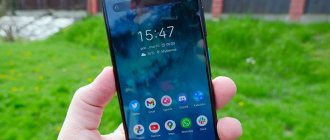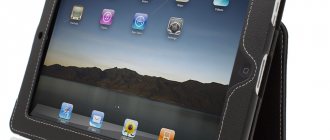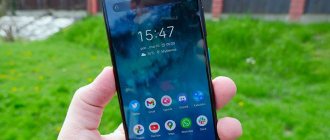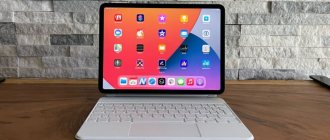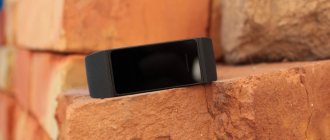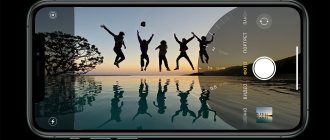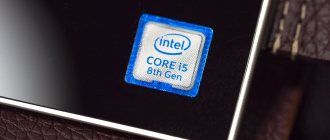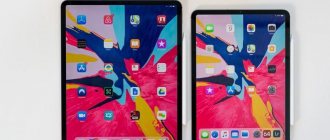After the massive appearance of tablets with 7-8-inch display diagonals, interest in classic 10-inch models has greatly diminished. Moreover, the manufacturers themselves were to blame for this: they built up the “muscles” of the tablets, which is why these devices turned out to be expensive and heavy. It’s not surprising that the much more compact, lightweight and affordable “seven-inch” cameras eventually became more popular.
Apple thoroughly analyzed the shortcomings of the 10-inch models and tried to eliminate them all in one fell swoop - breathing new life into the tablet category that seemed to have lost its attractiveness. Here the new Apple A7 processor came in very handy, which only the lazy didn’t kick for “nobody needs 64-bit.” But the point of this processor is not 64-bit computing as such. And in a very advantageous combination of high performance and low power consumption - which combination ultimately made it possible to make the iPad Air what it became. However, first things first.
⇡#Design
This time it’s clearly not possible to get away with the shortest review in the world, as with the iPad Mini: iPad Air is the brightest thing that happened to full-size iPads in their entire history, not counting, of course, the release of the very first iPad. Literally everything has changed - from the design to the processor architecture, from the number of speakers to the appearance of the operating system.
Let's start with the design. Everything is simple here: the iPad Air is like an iPad Mini, only big. The new iPad got literally everything from Mini: proportions, a thin frame on the sides of the screen, straighter corners than The New iPad, and even two separate volume buttons on the right side instead of a monolithic rocker. By the way, now the 10-inch iPad, like the Mini, has stereo speakers, and also - for the first time in the history of iPad construction - two microphones.
The name Air is more than appropriate for our guest: the iPad has become about 16 mm narrower, a millimeter shorter and almost 2 mm thinner. The main thing is that it is now noticeably lighter: under the iPad Air with LTE, our scales show 479 grams, and under the iPad 4 in the same “cellular” version – 662 grams. This is really almost the most important change in the Air - one of the authors of this review at one time moved from the iPad 3 to the iPad Mini precisely because the 10-inch version was getting tired of his hands. Your hands practically never get tired of the Air—you can hold it suspended for any length of time without any problems. If previously a full-size iPad was more than two times heavier than a Mini, now it is only one and a half times heavier, which is already quite acceptable.
The weight has decreased for several reasons: firstly, the tablet itself has become smaller, secondly, the body panels have become thinner and lighter, thirdly, a thinner - and lighter - display has been used, and fourthly, the battery capacity has significantly decreased. Reducing the thickness of both the case itself and the aluminum sheet from which it is made, as well as the glass that covers the display, also affects the rigidity of the tablet. It’s impossible to bend the iPad Air, but it’s easy to push the matrix until streaks appear on the screen. This is much more difficult to do on the iPad 4.
The Home button in the iPad Air remains a button - there is no fingerprint sensor in the tablet
Along with the body, the color of the iPads has also changed - now they use exactly the same anodizing option as in the iPad Mini or iPhone 5/5s. We don’t know what will happen with the iPad Air, but on other devices it has the unfortunate property of chipping and scratching quite quickly. To protect the back of the tablet from damage, Apple is now offering Smart Cases for $79 each. Smart Case differs from Smart Cover not only in price, but also in the fact that the tablet is simply inserted into such a case, as if into a frame - without any magnets. The Smart Case also protects the tablet from the back, almost completely hiding it behind a layer of plastic that tries very hard to look like leather.
By the way, the top cover of the Smart Case, like the new Smart Cover, is not four-section, but three, like the Mini - this makes the case itself a little more wear-resistant, but slightly worsens its “stand function”: it’s much easier to drop the iPad in the new case from a vertical position. Another inconvenience of the Smart Case is that the power and volume buttons are hidden behind a layer of the same “leather plastic” - as a result, they are quite difficult to press, especially blindly.
What’s interesting is that if you put the “Air” and the “four” side by side, the latter, compared to the first, suddenly seems outdated and somehow very Chinese. Somehow, quite imperceptibly, fashion has changed, and what previously seemed strikingly beautiful is now no longer so attractive - or even repulsive. But the iPad Air looks quite modern.
The screen is large and clear, but LCD
The display of the new 2022 product has become slightly larger, 10.9-inch rather than 10.5-inch. Enlarging the screen did not affect the weight of the device. It is still as light and weighs only 458 grams. The Pro, by the way, has an 11-inch screen. A little bit, but more, although you may not pay attention to such a minor difference. This is achieved mainly by the fact that the frames of the Pro version are a little narrower.
I like the screen. In terms of quality, it is not inferior to that which was equipped with the more expensive iPad Pro. Apple calls these screens Liquid Retina Display. Its resolution is 2360 x 1460 pixels and the image density is 254 pixels per inch. It supports a wide P3 color gamut and Apple True Tone technology, designed to automatically adjust colors based on ambient lighting. Protection against accidental touches of the touchscreen works well, although not absolute.
However, certain advantages were reserved for the top model. The iPad Pro's screen refreshes at 120Hz (not 60Hz like the Air's display). It's also slightly brighter at 600 nits rather than the Air's 500. But even without the increased refresh rate, the animations are very smooth.
When I type texts, watch movies, websites or photographs, everything looks clear. Sharpness is high, but without oversaturation. Thanks to the anti-glare coating, viewing angles are quite wide.
Unfortunately, Apple never equipped its tablets with OLED displays. “Liquid” is translated from English as “liquid,” which means the screen is still liquid crystal. The difference is not noticeable either on the home screen or in applications with a white background. But after spending a few hours in Google Docs with dark mode turned on, I noticed that even older iPhone models outperform the new iPhone when it comes to accurately reproducing rich blacks. But in arcade games with a bright color palette, the display is good. The colorimeter showed that my tablet screen covered about 103% of the sRGB spectrum.
The image density of 264 pixels per inch is noticeably inferior to that characteristic of the new iPhone (450 ppi). But I didn’t notice any pixelation, nor was there a blurry picture. The tablet is held further from the eyes than the phone, which means the density indicator is less important.
⇡#Display
The new iPad uses a different matrix model (or rather, “models” - there are probably several suppliers). The diagonal and resolution, of course, have not changed at all - still the same 9.7 inches, still the same 2048x1536 pixels. But other characteristics still differ. Not so much that it makes sense to shout about revolution, but still the screen has clearly become a little prettier - to approximately the same extent (and according to the same parameters) as in the new iPhones.
The brightness has increased by about 10-15%. Contrast – by a hundred units, from 700:1 to 800:1. This is not to say that the display has become amazingly bright, but in the sun it will be a little easier to see the image. A trifle - but nice.
There are also positive changes in terms of color rendering. The shape of the color gamut triangle has been “corrected” for the display, so now it corresponds significantly better to sRGB. The colors did not become more saturated - but they became more correct and natural.
The image became a little warmer and brighter: the color temperature became less high and more uniform across the gradient.
The gammas have become a little less accurate - but not so much that the difference can be seen without the help of a device.
The display in the previous iPad was very good, but in the new one it has become a couple of small steps closer to perfection. A little higher brightness, a little higher contrast, better color rendition. Apple could not have done all this, but they did. And thanks to them for that.
⇡#Iron
Like the new iPhone 5s, the iPad Air is based on Apple's 64-bit A7 chip with an additional M7 coprocessor (the latter is actually called NXP LPC18A1 and Apple has nothing to do with its development). This is a rare case when Apple decided to use the same chip in a tablet as in a smartphone - without any “X” or enhanced graphics, as was usually the case. The tablet chip is slightly different from the smartphone chip, which is noticeable primarily by the markings (APL5698 here and APL0698 in the iPhone). However, at first glance, the whole difference is that in the tablet version of the A7, the processor cores operate 100 MHz faster - at a frequency of 1.4 GHz instead of 1.3. And architecturally, the processors are absolutely identical: it’s the same 64-bit ARMv8 chip with two Cyclone processor cores and PowerVR SGX G6430 graphics.
| Apple iPad 4 | Apple iPad Air | |
| Display | 9.7 inches, 2048×1536, IPS | 9.7 inches, 2048×1536, IPS |
| Touch screen | Capacitive, up to 10 simultaneous touches | Capacitive, up to 10 simultaneous touches |
| Air gap | Eat | Eat |
| Oleophobic coating | Eat | Eat |
| Polarizing filter | Eat | Eat |
| CPU | Apple A6X two Apple Swift cores (ARMv7 A32); frequency 1.4 GHz; process technology 32 nm HKMG | Apple A7: two Apple Cyclon cores (ARMv8 A32/A64); frequency 1.4 GHz; 28 nm process technology HKMG Apple M7 coprocessor (NXP LPC 1800): single ARM Cortex-M3 core, 180 MHz (ARMv7-M) |
| Graphics controller | Imagination Technologies PowerVR SGX 554MP4 | Imagination Technologies PowerVR G6430 |
| RAM | 1 GB LPDDR2 | 1 GB LPDDR3 |
| Flash memory | 16/32/64 GB | 16/32/64/128 GB |
| Connectors | 1 x Lightning 1 x 3.5mm headset jack 1 x Micro-SIM | 1 x Lightning 1 x 3.5mm headset jack 1 x Nano-SIM |
| cellular | Qualcomm MDM9615 external modem, RTR8600 transceiver: 2G: GSM/GPRS / EDGE 850/900/1800/1900 MHz 3G: DC-HSPA+ (42 Mbps) 850/900/1900/2100 MHz 4G: LTE Cat. 3 (102 Mbit/s) without support for Russian Nano-SIM frequencies | External modem Qualcomm MDM9615, transceiver WTR1605L: 2G: GSM/GPRS/EDGE 850/900/1800/1900 MHz 3G: DC-HSPA+ (42 Mbit/s) 850/900/1900/2100 MHz; CDMA EV-DO 800/1900 MHz 4G: LTE Cat. 3 (102 Mbps) band 1, 2, 3, 4, 5, 7, 8, 13, 17, 18, 19, 20, 25, 26 Nano-SIM |
| WiFi | 802.11 a/b/g/n, 2.4/5 GHz | 802.11 a/b/g/n, 2.4/5 GHz |
| Bluetooth | 4.0 | 4.0 |
| NFC | No | No |
| IR port | No | No |
| Navigation | GPS, A-GPS, GLONASS | GPS, A-GPS, GLONASS |
| Sensors | Light sensor, proximity sensor, accelerometer/gyroscope, magnetometer (digital compass) | Light sensor, proximity sensor, accelerometer/gyroscope, magnetometer (digital compass) |
| Main camera | 5 MP (2592×1936), Autofocus | 5 MP (2592×1936), Autofocus |
| Front-camera | 1.2 MP (1280×960), back-illuminated matrix | 1.2 MP (1280×960), back-illuminated matrix |
| Nutrition | Non-removable battery 42.5 Wh | Non-removable battery 32.4 Wh (8827 mAh, 3.7 V) |
| Size | 241×186 mm Case thickness 9.4 mm | 240×170 mm Case thickness 7.5 mm |
| Weight | 662 g | 479 g |
| Water and dust protection | No | No |
| operating system | iOS 7.0.3 | iOS 7.0.3 |
Also, as our colleagues from Anandtech.com were able to discover, the processor in the iPad Air is able to operate longer at maximum frequency than the chip in the iPhone 5s - in other words, it throttles less often and less willingly. Obviously, the point is a larger case - and, accordingly, more intense cooling. The processor in the iPhone 5s can squeeze out a maximum of 2 minutes, after which its performance abruptly decreases by almost one and a half times, while the power of the iPad Air almost does not decrease over time.
The PowerVR SGX G6430 graphics, part of the new Rogue family, appears to run at 450 MHz - the same as in the iPhone 5s. Its performance per clock is the same as that of the SGX 554MP4 installed in the iPad 4, but the frequency seems to be higher - almost twice as high. As a result, the iPad Air will perform better in most graphics tasks than its predecessor. Although this cannot be predicted with 100% certainty - after all, the architectures of video adapters are fundamentally different, the old one may be better suited for one type of task, the new one for another.
The convenient, but expensive and proprietary Lightning is still used for charging and connecting to a computer.
The GPU does not have its own memory - this is not the Iris Pro Graphics 5200, so the entire system-on-chip has to manage the common LPDRR3 RAM - and here, like in the iPhone, it is only 1 GB. And if for a smartphone with a resolution of 1136x640 pixels more than a gigabyte of memory is definitely not needed, then for a tablet with 2048x1536, in theory, it may not be enough. Yes, it was enough for the iPad 4, but with the transition to 64-bit rails, application appetites for memory increased by about 20-30%. We didn't have time to play everything we wanted to on the iPad Air, but in practice we didn't experience a lack of memory. And yet we assume that the next generation of iPads will already have 2 GB of RAM.
Addition: Readers suggest that we forgot an important point: the Apple iPad Air can be equipped with 128 GB of internal memory, while the iPad 4 and earlier models have a maximum of 64 GB. The transition from 64 to 128 GB, like all other iterations of increasing storage capacity, raises the cost of the tablet by $100.
In mobile devices, Apple decided not to rush to introduce Wi-Fi 802.11ac - so MacBooks have the appropriate adapters, but iPhones and iPads have to be content with the 802.11n standard. And in the case of the iPad, this is certainly not due to the fact that full antennas did not fit into the device.
But with cellular communication everything is fine. The iPad Air is powered by the older Qualcomm MDM9615 multi-band modem, used, for example, in the iPhone 5. Let us remind you that it is capable of operating in all modern LTE bands, but this, as we know, is not enough - the number of 4G bands in which The tablet itself can work, it also depends on the transceiver. The transceiver, as in all other modern Apple devices, is younger than the modem - it is the Qualcomm WTR1605L, the most omnivorous of the existing LTE transceivers. But the capabilities of the modem and transceiver are also not enough; to be omnivorous, you also need to equip the device with signal amplifiers. And here we come to the most interesting part: the relative space inside the body of the new iPad Air made it possible to place a whole bunch of amplifier chips on the motherboard: as many as five for LTE and one more for 2G/3G networks.
The iPad Air, like all modern Apple devices, uses nano-SIM. It’s interesting that the new iPad comes with a wire “Iceclip” rather than a cast one, like the iPhone 5c
As a result, Apple has only one LTE iPad Air model in its product range - A1475, but it works on all LTE networks in the world, with the exception of Chinese TDD-LTE. This is convenient: firstly, you will not be left without communication wherever you go (well, except for China - however, the networks there are still not launched), secondly (lucky for a Russian person) iPads can now be carried practically from any country - and they will work in Russian LTE networks. One day. Because now, as far as we know, for all sorts of different reasons, they don’t work with LTE, just like iPhones. This, however, remains to be verified.
A little history
The very first Apple iPad , then just an “iPad”, without serial numbers or generations, was announced on January 27, 2010. The device hit store shelves only two months later, and this was the longest time gap between the announcement and deliveries; in the future, Apple tried to maintain a waiting period of about a week. Naturally, Apple expected its product to become popular, but the actual numbers turned out to be even more impressive than expected. In just the first month of sales, the first million tablets were sold; it took a little less than three months to reach the 3 million mark, and just before the announcement of the iPad 2, Apple sold 15 million first-generation tablets, occupying 75% of the nascent Tablet PC segment at the end of 2010.
The second generation of the tablet, logically named Apple iPad 2 , was presented and released for sale a year later, in March 2011. Back then, no one could have imagined that this model would become the longest-lasting in the line of tablets from the Californian company (remember that the iPad 2 is still on sale, unlike the discontinued iPad 3 and 4). The design and hardware platform were updated for the new product, the body became noticeably lighter, but the screen remained the same - 9.7-inch IPS with a resolution of 1024 by 768 pixels (132 PPI). And this despite the fact that by that time the iPhone 4 with a Retina display, the pixel density of which was 326 PPI, had already been on sale for 9 months. That is why those users who purchased their first iPad not at the start of sales, but a little later - during the back-to-school period and the Christmas holidays, chose not to upgrade to the Apple iPad 2, but to wait for the next Retina model. Interestingly, it was in the second generation that the iPad introduced Smart Covers - smart covers that allowed you to unlock the screen using a built-in magnet and could transform into a stand for watching videos or typing.
The expectations of fans of Retina displays in tablet format were met exactly a year later, in March 2012. It was then that the leapfrog with names began, the company itself preferred the designation The new iPad , while “popularly” it was more often referred to under the pseudonyms Apple iPad 3 or Apple iPad Retina . The new product received an improved Apple A5X processor with quad-core PowerVR SGX543MP4 graphics and double the amount of RAM, which were simply necessary in order to “pump up” four times the number of pixels (2048 x 1536, 264 PPI). The downside of the upgrade was the need for a reinforced battery, its capacity increased from 25 to 42.5 Wh, as a result, the third generation of the tablet again became heavier, almost to the level of the very first iPad. The second problem was the noticeable heating of the Apple iPad 3 case under load, caused by a powerful, but not the most energy-efficient, filling. Thus, users got what they wanted for so long - a screen with an ultra-high resolution, but in terms of other user characteristics (weight, thickness, heating, autonomy), the new product was inferior to the previous generation.
It is unlikely that the company itself did not understand that the iPad 3 turned out to be quite controversial. Apparently, this is why Apple did not maintain the usual annual interval and introduced the next fourth generation of the tablet after only 7.5 months. The second reason for such an early update of the line could also be the readiness to announce the company’s new brainchild - the 7.9-inch Apple iPad mini , delaying the release of which would mean handing over the tasty segment of compact budget tablets to other companies. And yet, even this wave of renewal was greeted coolly by the most critically minded consumers. The new Apple iPad 4 was an expected, but not very impressive, bug fix, upsetting all iPad 3 owners in the process, who clearly did not expect their new product to “turn into a pumpkin” so quickly. Well, the main complaint about the Apple iPad mini was the screen with an antediluvian resolution of 1024 by 768 pixels and a hardware platform from the obsolete Apple iPad 2. And it doesn’t matter that with such a screen diagonal, the pixel density was better than that of the first two older iPads, and the performance the filling was quite enough for such a resolution. Everyone wanted Retina and hardware from the older iPad...
And now, they finally got them. At an event that took place just a week ago, Apple showed two new products at once. The older Apple iPad Air became the company's most compact and lightest “large” tablet, dropping 180 grams / 28% of weight and 1.5 mm / 20% of thickness. Well, the younger Apple iPad mini with Retina display (iPad mini 2) finally received the long-awaited Retina display with a resolution of 2048 by 1536 pixels and a progressive hardware platform completely similar to the iPad Air - Apple A7 processor with 64-bit architecture and M7 coprocessor . Thus, we only have to confirm in practice whether the new Apple iPad Air and Apple iPad mini with Retina display, which are almost perfect on paper, are really that good.
⇡#Performance
We have already seen how the Apple A7 works using the example of the iPhone 5s. It works impressively, I have to admit. The slightly optimized and overclocked A7, as it turns out, looks even better. At least in 3DMark IceStorm Extreme, the result of the iPad Air is almost 1.5 times higher than that of the iPhone 5s, and there’s no need to talk about the iPad 4. Yes, yes, this low result is an indicator of that same iPad 4, the graphics power of which scared tablet manufacturers six months ago - they say, you won’t reach it.
In IceStorm Unlimited, the result is not as expressive, but the accelerated processor with better cooling (relative to the iPhone 5s) plus improved graphics (compared to the iPad 4) still make themselves felt.
In Basemark X, our test subject behaved strangely - he simply does not run in the Offscreen test, so we only have results in the native iPad resolution of 2048x1536. Of course, the results are disappointing: Basemark X is a very difficult test, it does not work at normal speed even on Full HD displays, so there is nothing to say about “retina”. Of course, the iPad Air does better than the iPad 4, but it's still very pale. However, there are no such heavy mobile games, so in a practical sense there is nothing particularly to be sad about.
The GFX Benchmark clearly illustrates how difficult it is for mobile graphics to work with retina. In the simple Egyptian HD scene, in both resolutions, the difference between the old and new iPads is 10 FPS, but when moving from Full HD to 2048x1536, the tablets’ performance drops by a little over ten. And if in Full HD the results are definitely good, then when running in 2048x1536 it’s already frankly difficult for the old iPad.
In the heavier scene, T-Rex HD FPS does not reach an acceptable level on any of the tablets. Only Air shows at least a decent figure and only in Full HD resolution (that is, in Offscreen mode). T-Rex (like Basemark X) is a plus or minus level of detail and, accordingly, the demands of those games that are currently in development and will be released in a year or two. Accordingly, it will be basically impossible to play them in the iPad’s native resolution and in maximum quality. Even on the new, powerful iPad Air - and on iPad 4 and older, everything looks completely sad.
Display, interface
the Apple iPad Air display remain unchanged; it is a 9.7-inch IPS matrix with a resolution of 2048 by 1536 pixels and a pixel density of 264 PPI. Viewing angles and color gamut are traditionally at their best, the picture remains juicy and realistic at any screen position. The brightness of the display backlight can be adjusted from 5 to 360 cd/m2, while exactly in the middle of the scale it is optimal for indoor use at 130 cd/m2. The capacitive touch layer with multi-touch support allows you to use various multi-finger gestures, there are no complaints about sensitivity. The system perfectly handles false positives, which have become more frequent due to the reduction in the width of the screen bezel.
The Apple iPad Air tablet comes pre-installed with the iOS 7 operating system, which has a noticeably redesigned interface compared to iOS 6. Some users do not like the new flat icons, flashy colors, parallax effect and other features of the new system, but any system sooner or later undergoes a redesign, which ordinary users have to put up with. You can read more about the iOS 7 operating system in our review “ iOS 7: the future will be bright... and flat ” here.
⇡#Camera
Formally, the camera characteristics of the new iPad remain the same as the previous one: they are the same down to the letter and punctuation mark. However, in fact, the camera module has become completely different - simply because the thickness of the body has changed. There was no longer enough space for the old module, so the engineers had to build a new one.
Apple iPad Air front camera
As a result, there is still a difference between the photographs - and it is not as small as one might think. Actually, the only thing the frames have in common is the resolution: in both cases it is 5 megapixels, and to be completely accurate, then 2592x1936 pixels. We are accustomed to the fact that in new generation devices the quality of photography is, as a rule, better than in any “old” ones. But this is not the case: the new camera obviously shoots worse than its predecessor.
Apple iPad Air rear camera
Even in comfortable conditions, the difference is easy to notice. Footage taken on the iPad Air turns out faded and blurry. The HDR algorithm has seriously changed: the iPad 4 unobtrusively equalizes the brightness level of different parts of the image, while the iPad Air greatly brightens it, in the process overexposing well-lit objects.
The new camera tends towards less pleasant cold tones and is much more noisy. When shooting at night with the iPad 4, there were still some chances of getting a decent shot, but with the iPad Air they became very slim.
However, perhaps this is for the better. Probably, the new iPad model will discourage people from taking photographs with a tablet and the number of people who like to “click with shovels” will finally decrease.
Characteristics of Apple iPad Air (2020)
| Screen resolution | 2360x1640 pixels |
| Pixel Density | 264 ppi |
| Rear camera | 12 MP f/1.8 |
| Video recording | 4K at 24, 30 or 60 fps; 1080p slow motion at 120 or 240 frames |
| Front camera FaceTime | 7-MP; video 1080p |
| CPU | Apple A14 Bionic |
| Autonomy | Up to 10 hours via Wi-Fi; up to 9 hours on cellular network |
| Headphone jack | No |
| Connectors and ports | USB-C; Apple Smart |
| Apple Pencil compatibility | Yes; second generation |
| Unlock | Touch ID |
| Wi-Fi, Bluetooth | 802.11ax, Bluetooth 5.0 |
| SIM card support | Nano SIM; eSIM |
| Keyboard support | Magic Keyboard, Smart Keyboard Folio |
| Audio and sound | Two speakers |
| Dimensions and weight | 247.6×178.5×6.1 mm, 458 grams |
| Price | From 55,000 rub. |
⇡#Battery
Let us remind you that the iPad Air has become thinner and lighter primarily due to a smaller battery. In the iPad 4, the battery had almost the capacity of a laptop - 42.5 Wh. In the new iPad, it has lost almost a quarter of its weight - now its capacity is a more reasonable 32.4 Wh (8827 mAh, 3.7 V). The battery consists of two flat cells, which are almost tightly attached to the back cover of the tablet and, according to iFixit, bend when you take them out. The same iFixit writes that this is the most terrible (of course, in terms of maintainability) battery they have ever encountered.
The battery capacity has become smaller, but the power consumption of the processor and display has also decreased - so it’s not easy to predict battery life. We launched a Full HD video in an endless loop with maximum brightness, muted sound and wireless interfaces - and found out that in this mode the iPad Air lives even slightly longer than the iPad 4. The Air lasted almost 8 hours, the Retina lagged behind almost for an hour. True, both are very cool results.
⇡#Soft
Colleague Kosikhin told us almost everything you wanted to know about iOS 7 in his review of this operating system. On a large display, the “seven” looks about the same as on a small one, so there’s not much to say about it.
Nevertheless, there are still important changes in terms of software in the iPad Air - from now on, the iWork and iLife packages are supplied free of charge with the new iPad. Let's remember that the first includes the text document editor Pages, the processor for working with Numbers tables and the utility for creating Keynote presentations, and the second includes the music editor Garage Band, the video processor iMovie and the photo editor iPhoto.
Free is good, but you still need to take into account that the term “shareware” is more applicable here: in some applications you can buy additional content. For example, GarageBand allows you to purchase instruments and sounds that are not available in the free version. On the other hand, the presence of such a basic set of applications makes the iPad a much more functional contraption. You just need to download them - initially, none of the programs are installed on the tablet; you will be offered to download them when you first enter the App Store. They won’t remind you anymore, but this won’t make it any less free.
